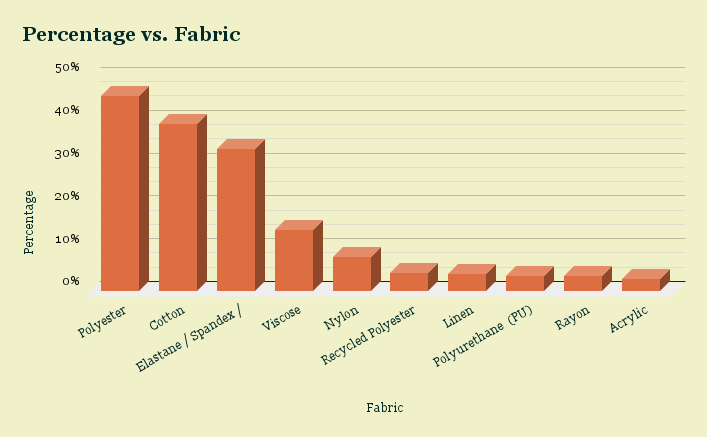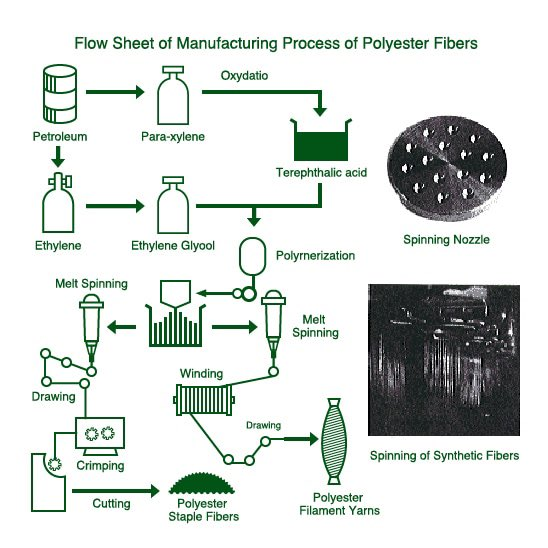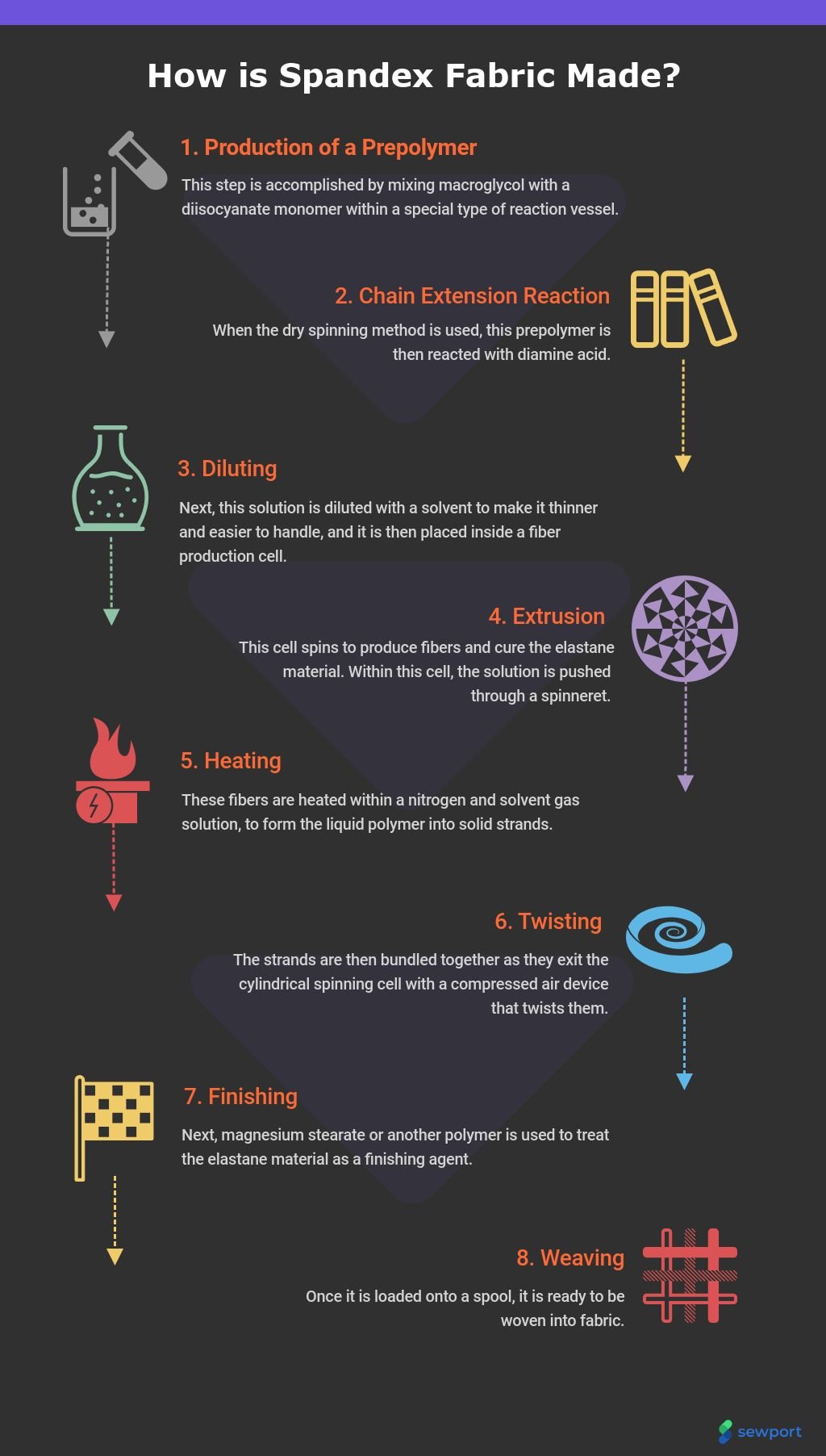The Encyclopedia of Fabrics
Reading clothing tags can be extremely misleading and confusing if you aren't aware of the intricacies of fabrics. You might think you are wearing clothes made out of truly sustainable, healthy materials when in reality you are wearing toxic clothing that is not only harmful to your well-being, but also to the planet.
Wayve deeply cares about the quality and materials we use to create our garments, and believe that the world would be a better place if natural fabrics were the default rather than synthetics. In this blog post, we will take a look at the top fabrics used in the fashion industry, and clearly break down what each one is made of, talk about the pros and cons, and finally give it a grading.
Most popular fabrics of today's fashion industry
In 2022, some of the top fashion brands were analyzed and the materials they used were recorded. The overall popularity of the fabrics is visualized below:
Brands include: Nike, Zara, Fashion Nova, Forever 21, ASOS, Shein, Gymshark, Uniqlo, Target, and more.
Great, so now we know what the big brands are using to manufacture their clothes. But what are these fabrics and what does wearing them mean for your health?
1) Polyester
Because of how inexpensive polyester is to produce and the versatility of the fiber, the fashion industry has made polyester the fabric of choice over the recent decades. Polyester alone makes up a staggering 50% of the fabrics used in America today. And this number is still rising. Sadly, the average consumer's health and the impact on our Earth has been neglected in this decision.
Derived from: Petroleum
Commonly found in: Quite literally, everything
Pros: Cheap, versatile
Cons: Endocrine disruptor, fertility killer, microplastic spreader, takes hundreds of years to degrade
Grade: F
Polyester is to the fashion industry as seed oils are to big food industry. Both are found everywhere, both are cheap, and both are horrendous for your health. Avoid at all costs. Have a gander at how complex the process of making polyester is... Starting with petroleum (a bad enough start), the process includes several stages of chemical cleansing, extreme heating, spinning, melting, and additional chemical treatment.
2) Cotton
A caveat with this one is that "cotton" on a clothing tag is referring to conventional cotton. While this is miles better than polyester, we do still have some qualms with conventional cotton. Cotton is produced from the cotton plant. After the white fluffy part of the cotton is picked, the process to turn it into a wearable fabric is quite simple. It goes through a spinning process, turning the cotton into a type of yarn/thread. From there, it is woven and the result is cotton as you know it. Much simpler and more natural than the process required to produce polyester. The pitfall of conventional cotton though, is that like all the other conventional crops in America, it is sprayed with pesticides and herbicides. In fact, conventional cotton is sprayed more than any other crop in the world with things like Roundup that are made of glyphosate, which impact our nervous system.
Derived from: Cotton plants
Commonly found in: Everyday clothing, shorts, tees, hoodies
Pros: Natural clothing, versatile, durable, soft
Cons: Conventional cotton is the world’s “dirtiest” crop. It is the most heavily sprayed crop in the world and likely contains traces of glyphosate/other pesticides.
Grade: B+
3) Elastane / Spandex / Lycra
Spandex and elastane are interchangeable terms that mean the same thing. Lycra is a registered trademark that produces elastane/spandex. For simplicity sake, these are all the same thing and we will group them as one. At its core, spandex is plastic. Take a look at how it's made - it's quite similar to polyester production.
Spandex is a fully synthetic fiber and in order to create it, you have to treat it with a plethora of chemicals in a lab. Be mindful of this one, as sometimes clothes are labeled as "organic" even though they may contain up to 5% elastane. It's a really common fiber to mix with other fibers.
Derived from: Plastic (polyurethane based)
Commonly found in: Sportswear, swimwear, yoga pants, and underwear
Pros: Super elastic and stretch, durable
Cons: Takes hundreds of years to decompose, not breathable, made with toxic chemicals that leach into your skin
Grade: D-
4) Viscose
Viscose is a somewhat controversial fabric in the fashion industry. For me, it's not very controversial. We wouldn't recommend wearing viscose for both health and environmental reasons. Viscose is derived from wood pulp / plant cellulose. Think bamboo, eucalyptus, or pine fibers. Taken out of context, that sounds like a good natural fabric option. However, the process to turn that cellulose into a wearable fiber requires heavy chemical treatment with toxins including carbon disulphide. From an environmental perspective, Viscose production contributes to forests depletion, thus endangering lots of animal species and local communities. There's no need to hurt our furry friends.
Derived from: Wood pulp
Commonly found in: Blouses, dresses, skirts, jackets
Pros: Hypoallergenic, breathable, similar to properties cotton and silk
Cons: Made with toxic chemicals, net negative impact on environment
Grade: C-
5) Nylon
Nylon is extremely similar to polyester. It is plastic / petroleum based, and it leaches microplastics into the air and onto your skin. It leads to health problems and is terrible for the environment. Refer back to the polyester section for more details on this one, since they are so similar.
Derived from: Plastic / Petroleum
Commonly found in: Swimwear, sportswear, windbreakers, raincoats, tights, compression shorts, wetsuits
Pros: Elasticity, resistance to tearing, water resistant
Cons: Endocrine disruptor, fertility killer, microplastic spreader, takes hundreds of years to degrade, not breathable
Grade: F
6) Recycled Polyester
Recycled Polyester is more of a greenwashing tactic rather than being truly sustainable. Don't let the word "recycled" fool you. While recycled polyester isn't directly made of petroleum like traditional polyester, it is instead made from trash found in the ocean or landfills. Plastic water bottles, fish nets, etc. are "recycled" into clothing and big brands can call themselves sustainable for doing so. Since these fabrics are made of plastic that has been treated, they are extremely susceptible to releasing microplastics from regular wear and tear, and especially when washed in your washing machines & dryers. These microplastics are dispersed in the air, onto your skin, and eventually back into the ocean where they wreak havoc on the natural ecosystems for hundreds of years until they can biodegrade. On the human health side, microplastics can enter your bloodstream through your skin (your skin is super absorbent) and that leads to a variety of health issues, including destroying your fertility.
Derived from: Post-consumer plastic waste
Commonly found in: Everything
Pros: Cheap, versatile
Cons: You’re repurposing garbage to wear on your body, endocrine disruptor, fertility killer, microplastic spreader, takes hundreds of years to degrade, greenwashing
Grade: F
7) Linen
Finally, a good one! Linen is an incredible fabric, and we can't recommend it enough. Linen is made from flax plants, it is a completely natural fiber and potentially the oldest fabric ever produced (the first linen textiles date back nearly 10,000 years!) Linen is made from the cellulose fibers of the inside of the flax plant. It is breathable and can easily absorb as much as 20% of its weight in moisture before feeling wet. As an added bonus, linen keeps you warm in the winter and cool in the summer. The comfort that linen gives you is unique. Linen is also anti-bacterial, which is why we use linen for bandages even today. From a style perspective, linen can be dressed up or down, which makes it very versatile. Another cool aspect of linen is that it gets softer with time. The more you wear a linen garment, the more comfortable and soft it becomes.
Derived from: Flax plant
Commonly found in: casual to formal wear, including shirts, pants, dresses, blazers, vests, and jackets
Pros: Natural fiber, no chemicals/pesticides/excessive water required, high vibrational frequency 5,000 mHz
Cons: Usually more expensive
Grade: A+
8) Polyurethane
Polyurethane, AKA "PU" is not a fabric we would recommend. You'll find this fabric in vegan leather garments. While this may appeal to vegans, the reality is that it is doing more harm than good. PU faux leather fabric is made by applying a plastic layer to a base material like polyester, cotton, nylon, or rayon. Its production involves tons of non-biodegradable chemicals and solvents. So sure, you're not using animal products, but you are instead polluting the environment with microplastics + toxins, while exposing yourself to the undesirable effects they have on humans. It's a lose-lose situation, and definitely a fabric we would avoid.
Derived from: Plastic
Commonly found in: Faux leather clothing
Pros: Leather alternative
Cons: Heavy use of chemicals and solvents in the production process, source of microplastics, endocrine disruptor, fertility killer
Grade: F
9) Rayon
Rayon is a semi-synthetic fiber that resembles the texture and feel of silk. Modal, Lyocell, and viscose are types of rayon. The main differences between them lie in the fabric’s manufacturing processes. All of which include a heavy chemical bath. Rayon is made from wood pulp and undergoes intense chemical processing - essentially the same as viscose (#4 from the list). So rayon can sound like a good natural fabric, but in reality the sludge of chemicals used to produce it make this an undesirable choice both in terms of health and environmental impact.
Derived from: Wood pulp
Commonly found in: Sportswear and outerwear
Pros: Similar to properties cotton and silk, cheap
Cons: Undergoes heavy chemical processes that have a huge polluting impact on the environment. The production of viscose contributes to forests depletion, thus endangering lots of animal species and local communities. Also opens you up to chemical exposure.
Grade: C-
10) Acrylic
Acrylic is one of the most toxic fabrics humans have ever invented. While it may seem harmless and soft, it is actually something you really want to avoid. Acrylic fabric is made by reacting certain petroleum or coal-based chemicals with a variety of monomers, which means that acrylic fabric is a fossil fuel-based fiber. As you can imagine, this extremely unnatural process makes this fabric carcinogenic. It is also very flammable. From a performance perspective, it isn't even very intriguing, as it is prone to pilling more so than any other fabric we've heard of. It is known as an artificial wool alternative. Why we would ever need to do that, we have no idea. Real wool is a superb fabric, similar to linen.
Derived from: Fossil fuels
Commonly found in: Knitwear and sweaters
Pros: Resembles wool, lightweight, warm, soft
Cons: Carcinogenic, endocrine disruptor, microplastic spreader, highly flammable
Grade: F
That covers the top 10 most popular fabrics in the USA. We hope you learned something and enjoyed the read. As grim as this may sound, try not to get overwhelmed. You can slowly phase out these synthetic clothes from your closet, and try to only buy natural clothing when you do purchase new garments. This will leave you feeling healthier and more vibrant.
Below are some types of fabrics that have an A to A+ rating by Wayve. We will only use fabrics from this list!
- Organic Cotton
- Linen
- Wool (merino wool, cashmere, any type of legit wool really)
- Hemp
- Silk (specifically good for pillowcases)
- Leather (real leather)



